In-Depth Review of Da Vinci Resolve Video Editing Software
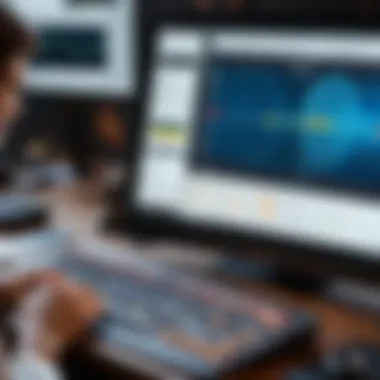
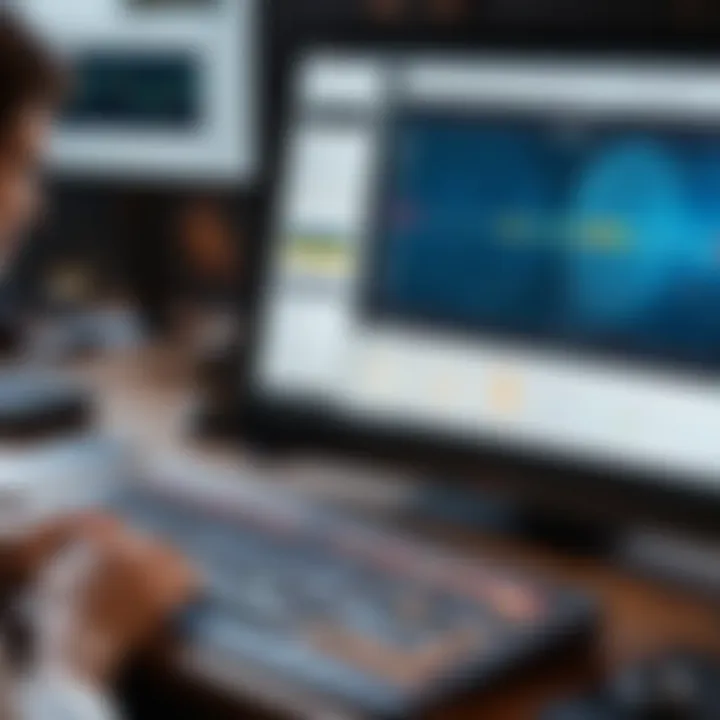
Brief Description
Da Vinci Resolve is a sophisticated video editing software that combines professional video and audio post-production capabilities. This platform has gained significant traction in the film industry, as well as among content creators and video enthusiasts. With an intuitive interface and in-depth functionality, it is well-suited for a range of users, from novices to seasoned professionals.
Overview of the Software
Developed by Blackmagic Design, Da Vinci Resolve stands out in the market due to its comprehensive suite of tools. It goes beyond standard video editing; it encompasses color correction, audio post-production, visual effects, and more. This all-in-one approach allows users to manage complex projects without needing to switch between multiple applications. The software has a distinctive modular design, enabling users to select and utilize features based on their specific needs.
Key Features and Functionalities
Some noteworthy features of Da Vinci Resolve include:
- Cut Page: Designed for quick editing, this feature streamlines workflows and is particularly useful for fast-paced projects.
- Color Grading: The software provides advanced color grading tools, giving users precise control over image color, contrast, and more.
- Fairlight Audio: This dedicated audio post-production suite includes recording, mixing, and sound design capabilities.
- Fusion: A powerful node-based compositor that allows for intricate visual effects and motion graphics.
- Collaboration Tools: Multiple users can work on the same project simultaneously, an essential feature for teams.
As a part of its continual development, the software frequently receives updates that enhance its features and performance.
System Requirements
To run Da Vinci Resolve efficiently, understanding its system requirements is critical. The right hardware and software environment can significantly affect user experience.
Hardware Requirements
- Operating System: macOS 11.1 or later, Windows 10 (version 1909 or later), or Linux.
- Processor: Intel Core i5 or AMD Ryzen 5 processor (or better).
- RAM: Minimum of 16 GB for HD projects, 32 GB for 4K, and 64 GB for intensive projects.
- GPU: A graphics card that supports OpenCL 1.2 or CUDA 11.1. Recommended options include NVIDIA GeForce RTX Series or AMD Radeon RX Series.
- Storage: A fast SSD is recommended for optimum performance, especially for large media files.
Software Compatibility
Da Vinci Resolve is compatible with various file formats and resolutions, ensuring flexibility in project management. Supported formats include:
- Video: MP4, MOV, AVI, MKV, and others.
- Audio: WAV, MP3, AAC, etc.
- Image: JPEG, PNG, TIFF, among others.
Users should ensure their system meets or exceeds these specifications to maximize the software's capabilities.
"Choosing the right hardware for Da Vinci Resolve can notably improve your editing experience, enhancing both speed and functionality."
In summary, Da Vinci Resolve offers an extensive range of features that cater to different levels of expertise in video editing. For those considering this software, an understanding of its capabilities and requirements can help in making a well-informed decision.
Preamble to Da Vinci Resolve
The introduction of Da Vinci Resolve serves as a vital doorway into understanding its significance in the realm of video editing. The software appeals to both professionals in the film industry and committed amateurs who wish to enhance their editing skills. Da Vinci Resolve is not merely a video editing tool; it encompasses extensive capabilities that include advanced color grading, audio post-production, and visual effects integration. This multi-functional nature allows users to tackle various stages of production within a single interface, streamlining workflow and increasing efficiency.
Overview of Video Editing Software
Video editing software can be broadly categorized into several types, ranging from basic applications aimed at casual users to complex platforms designed for industry professionals. The variety in this market reflects diverse user needs. For instance, software like Adobe Premiere Pro and Final Cut Pro are considered industry standards. However, what sets Da Vinci Resolve apart is its unique blend of powerful features and a free version that appeals to anyone interested in video editing.
Moreover, the rise in content creation has triggered a huge demand for accessible yet effective video editing software. Platforms like YouTube and social media have lowered the barriers to entry for sharing visual stories. Hence, tools that empower users at different skill levels become exceptionally relevant. The importance of a well-rounded software solution like Da Vinci Resolve cannot be overstated, especially in an age where visual communication is paramount.
The Evolution of Da Vinci Resolve
Da Vinci Resolve began its journey primarily as a color grading suite used in high-end film production. Over the years, it has evolved significantly. The first version was released in 2004, catering mainly to professional colorists. However, by 2013, Blackmagic Design acquired the software and brought it into the limelight by offering a free version. This crucial step broadened its user base, allowing independent filmmakers and hobbyists the same access to top-tier tools previously reserved for big-budget studios.
As of today, Da Vinci Resolve encompasses a unified workflow that integrates editing, color correction, sound design, and visual effects. This smooth integration marks a significant turn for the software, making it competitive with other notable industry players. As technology continues to advance, it is expected that Da Vinci Resolve will remain at the forefront of innovation in video editing, appealing to a broader range of users and adapting to changing needs.
Key Features of Da Vinci Resolve
Da Vinci Resolve stands out in the crowded field of video editing software primarily due to its robust and versatile features. In a world where content is continually evolving, editors need tools that are not only powerful but also user-friendly and efficient. The key features of Da Vinci Resolve encompass various aspects of video production, from editing to finishing touches. Understanding these features is crucial for anyone looking to maximize the software's potential either for professional projects or personal use. Each element plays a significant role in enhancing the overall workflow and quality of the final output.
Editing Capabilities
The editing capabilities of Da Vinci Resolve are extensive. The software provides a non-linear editing platform that allows users to cut and arrange video clips seamlessly. Users can apply various effects and transitions without disrupting the editing process. The timeline is intuitive, enabling editors to focus on their creativity without being hindered by technical limitations.
Some important aspects of the editing capabilities include:
- Multi-user collaboration: This feature allows multiple users to work on a project simultaneously, which can be important for larger teams.
- Advanced trimming tools: Users can make precise cuts and adjustments, which is particularly useful for fast-paced projects.
- Support for various media formats: Da Vinci Resolve accepts a wide range of video formats, ensuring flexibility during the editing process.
Editing in Da Vinci Resolve is not only about functionality but also about speed. Anyone familiar with video production knows that time is often of the essence.
Color Correction Tools
Da Vinci Resolve is renowned for its sophisticated color correction tools, which are integral to any video editing process. The software includes a dedicated color panel where users can fine-tune their footage. Control over color wheels, curves, and masks offers granular adjustments.
Some of the standout features include:
- Node-based color grading: This allows for complex and flexible color grading workflows. Users can work on multiple aspects of color correction in a visually organized manner.
- Color Match: This feature simplifies matching the color of different clips, which maintains visual consistency in the timeline.
- HDR support: Da Vinci Resolve supports High Dynamic Range content, catering to modern filming techniques and enhancing visual richness.
These tools not only provide the ability to correct color but also to enhance the storytelling aspect of the project through visual tone.
Audio Post-Production
Another key aspect is audio post-production. Da Vinci Resolve offers a comprehensive suite of audio editing tools tailored for any project scale. The Fairlight audio workspace includes powerful features designed for sound professionals.
Key elements of the audio capabilities include:
- Multitrack Recording: Users can record multiple audio tracks simultaneously, invaluable for projects requiring complex audio setups.
- Built-in audio effects: A range of audio effects and filters is readily available. This saves time searching for third-party plugins.
- Adaptive Automatic Ducking: This features automatically lowers the volume of music tracks when dialogue is present, ensuring clarity during scenes.
This focus on audio quality reflects the growing recognition of sound as a vital part of the video editing process.
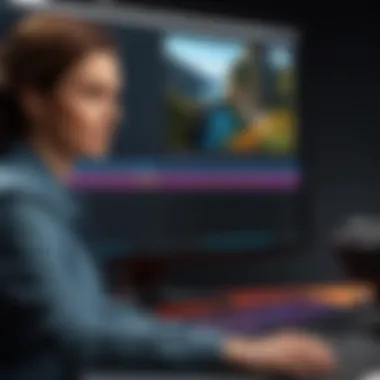
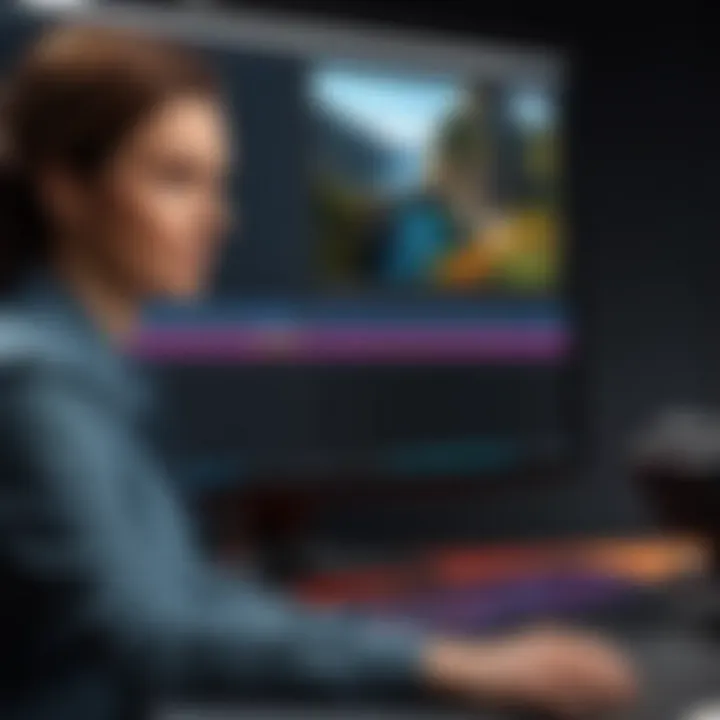
Visual Effects Integration
Visual effects are becoming increasingly essential in video editing. Da Vinci Resolve recognizes this trend by offering a robust Fusion module for visual effects compositing. The integration is seamless, allowing users to apply effects without leaving the primary editing workspace.
Main features to note include:
- Node-based compositing: Similar to color grading, the node-based system allows for creative freedom and complex effects layering.
- 3D compositing: Users can integrate 3D elements into their projects, expanding creative horizons.
- Pre-made templates: For those looking for quick results, a variety of templates and effects are available for fast incorporation into projects.
These features empower content creators to push the boundaries of their video projects and produce more engaging content.
"The ability to combine these elements smoothly makes Da Vinci Resolve a comprehensive tool for all aspects of video production."
In summation, the key features of Da Vinci Resolve not only highlight its capacity as a standalone editor but also showcase its role as an all-encompassing solution for video production and post-production. Understanding these aspects can greatly assist users in effectively utilizing the software for their specific needs.
System Requirements for Da Vinci Resolve
Understanding the system requirements for Da Vinci Resolve is crucial for any user aiming to utilize this software effectively. The right hardware setup not only ensures a smoother editing experience but also maximizes the software’s potential. Video editing can be demanding, requiring significant processing power and memory. Insufficient hardware can lead to performance issues, such as lagging playback and slow rendering times. This section will detail the minimum specifications needed to run Da Vinci Resolve, as well as recommended hardware upgrades for those seeking optimal performance.
Minimum System Specifications
To successfully install and run Da Vinci Resolve, users must meet certain minimum system specifications. These are designed to ensure that the software can operate without significant limitations. The minimum requirements generally include:
- Operating System: Windows 10 (64-bit) or macOS 10.14 or later
- Processor: Intel Core i5 or AMD Ryzen 5
- RAM: 8 GB or more
- Graphics Card: NVIDIA GeForce GTX 700 series or AMD Radeon HD 8000 series or Intel UHD 620 (with updated drivers)
- Video Display: 1920 x 1080 or higher resolution display
- Storage: SSD recommended, with at least 1 GB of free space for installation
These specifications are the bare minimum needed to run Da Vinci Resolve, allowing basic editing and minor color correction tasks. However, users aiming to dive deeper into the software's advanced features may find these specifications limiting.
Recommended Hardware for Optimal Performance
For a more efficient and productive editing experience, considering hardware upgrades is beneficial. Recommended specifications exceed minimum requirements and are aimed at professionals and serious hobbyists who need enhanced performance. Here are the recommended hardware specifications:
- Operating System: Windows 10 (64-bit) or macOS 10.14 or later
- Processor: Intel Core i7 or AMD Ryzen 7
- RAM: 16 GB or more (32 GB preferred for heavy projects)
- Graphics Card: NVIDIA GeForce GTX 1080 or AMD Radeon RX 5000 series or higher
- Video Display: Dual 1920 x 1080 displays or one 3840 x 2160 display for better workspace management
- Storage: NVMe SSD with at least 1 TB of space; separate SSD for media and cache files recommended
These upgrades lead to faster processing times, improved rendering speeds, and better overall stability while utilizing extensive features such as complex effects and multi-cam editing. In essence, investing in suitable hardware ensures a more enjoyable and effective video editing workflow.
"Running software like Da Vinci Resolve on hardware that meets or exceeds recommended specifications significantly impacts your editing experience."
In summary, assessing system requirements is a vital step in preparing to use Da Vinci Resolve. Meeting the minimum requirements is essential, but aiming for recommended hardware opens doors to a more powerful and efficient video editing process.
Installation Process
The installation process of Da Vinci Resolve plays a critical role in how users engage with this powerful video editing software. Understanding how to properly install the software can save time and reduce frustration later. Moreover, a seamless installation sets the foundation for a smoother experience. This section explains the key elements involved in downloading and installing Da Vinci Resolve along with benefits and considerations.
Downloading Da Vinci Resolve
Downloading Da Vinci Resolve requires users to visit the official website. Users need to ensure they are getting the latest version, which incorporates the newest features and fixes. Here are the steps:
- Navigate to the Da Vinci Resolve official website.
- Choose the version suitable for your operating system. Available options may include the free version and the paid Studio version.
- Click on the download button and follow the prompts that may include entering your email address.
It is advisable to check the system requirements first to ensure compatibility. The download file size can be significant, so having a reliable internet connection is important. Once the download is complete, the file will usually be found in the designated downloads folder.
Installation Steps
After the software has been downloaded, it is important to follow the proper installation steps. The installation guidelines are straightforward but require attention to detail to avoid any hiccup:
- Locate the downloaded installation file and double-click to start the installation wizard.
- Follow the on-screen prompts. Users may be prompted to review and accept the licensing agreement.
- Select the desired installation location. It is often wise to choose the default location unless space is a concern.
- Choose whether to create shortcuts or additional options based on your needs.
- Click on the "Install" button and wait for the process to complete. This may take several minutes depending on your system's specifications.
- Once finished, users will get a notification indicating a successful installation.
- Finally, it is recommended to restart the computer to finalize the installation process before launching Da Vinci Resolve.
Ensuring that all steps are properly followed is crucial. Failing to do so may result in software performance issues, errors, or crashes. The installation process is not just a procedural requirement; it sets the stage for usability and satisfaction with Da Vinci Resolve.
User Interface and Navigation
The user interface and navigation of Da Vinci Resolve play a crucial role in the software's usability and efficiency. As this is a complex video editing tool, a well-designed interface can significantly enhance the user experience. Users need to understand where to find tools and features quickly. This can save time and reduce frustration during the editing process. Navigating efficiently can lead to increased productivity, which is vital for both professionals and amateurs tackling video projects.
Workspaces Overview
Da Vinci Resolve allows users to work in different workspaces tailored for various tasks. The primary workspaces include Media, Cut, Edit, Fusion, Color, Fairlight, and Deliver. Each of these spaces is oriented towards a specific function in the video editing process.
- Media Workspace: This is where users import and manage their media files. It includes metadata management and media organization features.
- Cut Workspace: Designed for fast cutting and editing, this workspace offers streamlined tools and a simplified timeline.
- Edit Workspace: A more comprehensive suite of editing tools available for detailed work on timelines, effects, and transitions.
- Fusion Workspace: Here, advanced visual effects and motion graphics can be created. This space provides a node-based environment.
- Color Workspace: It is dedicated to color grading and correction, featuring advanced tools for professional film color correction work.
- Fairlight Workspace: Users can manage audio post-production and sound design in this area. It offers numerous audio effects and mixing capabilities.
- Deliver Workspace: This final workspace is for exporting your projects in various formats. Settings for resolution, codecs, and destination are configured here.
Each workspace in Da Vinci Resolve can be accessed easily through tabs at the bottom of the interface. Understanding the function of each workspace is essential for a smooth workflow.
Customizing the Interface
Customization is another notable feature of the Da Vinci Resolve interface. Users can modify layouts to suit their editing preferences and workflow needs. This flexibility can lead to a more intuitive experience.
Users can:
- Rearrange Panels: Move panels around according to what makes the most sense for one's workflow.
- Save Layouts: After organizing the interface, users can save their custom layouts for future projects. This is particularly useful for those who switch between various tasks often.
- Select Themes: Change the color theme to make the software visually more comfortable to use. This can lessen eye strain during long editing sessions.
- Keyboard Shortcuts: Customize keyboard shortcuts to enhance efficiency. Creating shortcuts for frequently used tools and commands can reduce the time spent navigating menus.
The options for customization in Da Vinci Resolve make it adaptable to any user's needs, be they a novice or a seasoned professional. This personalized approach can not only streamline the editing process but also enhance user satisfaction overall.
"A well-structured interface, combined with the ability to customize, elevates the video editing experience in Da Vinci Resolve."
Overall, the user interface and navigation are essential components of Da Vinci Resolve that contribute to its effectiveness as a professional video editing software. Understanding and mastering these elements can lead to greater efficiency and creativity in video projects.
Learning Curve


Understanding the learning curve associated with Da Vinci Resolve is essential for both novice users and seasoned professionals. The term 'learning curve' encapsulates the time and effort required to master the software's various features and capabilities. Given the complex nature of Da Vinci Resolve, it is crucial to identify the available resources and training options to make the learning process more manageable. The software is rich in capabilities, which can present challenges when first engaging with it, but utilizing the right resources can significantly enhance the learning experience.
As you embark on your journey with Da Vinci Resolve, expect an initial period of adjustment. Familiarity with basic video editing concepts can ease this transition, but complete beginners may find the interface and multitude of features daunting. Understanding the potential benefits of investing time in learning this software is important. For instance, mastering the editing tools can lead to improved productivity, while understanding color grading can elevate the quality of a project.
Resources for Beginners
For those new to video editing or Da Vinci Resolve specifically, a variety of resources can facilitate effective learning. Online tutorials, forums, and official documentation can provide you with valuable insights. Some key resources include:
- Official Da Vinci Resolve Training: Blackmagic Design, the creator of Da Vinci Resolve, offers free training videos on its website, covering from basic to advanced techniques.
- YouTube Tutorials: Many content creators have produced detailed tutorials on specific functions within Da Vinci Resolve. These can provide practical examples and tips for beginners.
- Online Courses: Websites such as Udemy or Skillshare offer structured courses tailored for beginners that guide through the software step by step.
- Community Forums: Engaging with the user community on platforms like Reddit can provide support, inspiration, and answer specific queries from experienced users.
These resources can serve as a foundation upon which user confidence and skills can build. Consider mixing different types of learning materials to create a more comprehensive understanding.
Advanced Training Options
Once you are comfortable with the basics and seek to refine your skills further, advanced training options are available. Engaging in more specialized materials can elevate your editing prowess. Some noteworthy options include:
- Workshops and Seminars: Participating in workshops can provide hands-on experience with direct feedback from instructors, which is invaluable for mastering advanced features.
- Certification Programs: Some institutions offer certification courses for Da Vinci Resolve that can lend credibility to your skills and potentially bolster career opportunities.
- Books and eBooks: Detailed guides and manuals can provide deeper insights into advanced techniques and case studies from professionals in the field.
- Project-Based Learning: Working on real projects, either personal or freelance, can challenge you to apply your skills and learn on the job. This practical application reinforces theoretical knowledge and fosters growth.
Investing in quality training material and experiences can be crucial for those looking to reach the next level of expertise with Da Vinci Resolve. The balance between theoretical understanding and hands-on practice is vital for comprehensive learning.
Applications of Da Vinci Resolve
Da Vinci Resolve's applications are wide-ranging and impactful, establishing its position as a favored choice among video editing professionals and hobbyists alike. Understanding how this software fits into various sectors can provide insights into its overall utility, strengths, and potential drawbacks. This section will explore two primary applications of Da Vinci Resolve: its use in film production and its growing adoption by YouTubers and content creators.
Use in Film Production
In the realm of film production, Da Vinci Resolve is often utilized for its powerful editing and color grading capabilities. Major film studios have adopted the software due to its robust feature set that includes editing, visual effects, and audio post-production tools. Film editors appreciate the seamless transition between these modules, creating a streamlined workflow.
Some notable benefits include:
- Advanced Color Correction: Da Vinci Resolve is renowned for its high-end color grading tools. The software provides features that allow for precision and creativity, enabling filmmakers to achieve a desired look that aligns with their vision.
- Collaboration Features: The multi-user capabilities allow various team members—like editors, colorists, and sound engineers—to work simultaneously on the same project. This is crucial in a fast-paced production environment where time is of the essence.
- Support for Various Formats: Da Vinci Resolve supports a wide array of video formats, making it adaptable to different filming styles and methods. This flexibility is vital in ensuring that production teams can work with the footage they have without converting files to a single format.
This capacity for versatility ensures that Da Vinci Resolve remains a top-tier choice in film production, balancing professional-grade features with usability.
Adoption by YouTubers and Content Creators
The rise of content creators on platforms such as YouTube has further popularized Da Vinci Resolve among this demographic. With the increasing need for high-quality video content, many creators are turning toward software that offers professional capabilities without the professional price most often seen with other tools.
Some noteworthy points regarding this adoption include:
- Cost-Effective Options: Da Vinci Resolve offers a free version that includes many essential features, making it accessible for budding creators. The free version enables users to initiate their projects without significant financial investment.
- User-Friendly Interface: While it has advanced tools, Da Vinci Resolve is designed with usability in mind. For YouTubers, the easy navigation allows for quicker editing and less time learning complicated workflows.
- Engagement Tools: Content creators are benefiting from features such as audio integration and color grading to enhance the quality of their videos. This attention to detail becomes crucial in a saturated market, where content often competes for viewer attention.
In summary, whether in the high-stakes world of film production or the fast-paced environment of YouTube content creation, Da Vinci Resolve provides essential tools that cater to the needs of diverse user groups. This adaptability makes it a valuable asset in various audiovisual projects.
Advantages of Da Vinci Resolve
Da Vinci Resolve has established itself as a leading video editing software, particularly among professionals in the film and video production industries. Understanding the advantages of this software is essential for users deciding whether it fits their needs. The benefits are numerous and span across various aspects of video editing, making it a competitive choice.
Cost Efficiency
One of the most significant advantages of Da Vinci Resolve is its cost efficiency. The software offers a powerful free version with robust features, often unparalleled by other video editing tools that typically require a subscription or one-time payment.
- The free version includes high-quality editing, color correction, and audio post-production tools that cover most needs for casual users and independent filmmakers.
- The paid version, Da Vinci Resolve Studio, offers additional features like advanced noise reduction and multi-user collaboration, which may be essential for larger productions. However, the cost remains reasonable compared to similar software, providing excellent value for money.
This cost effectiveness allows users, especially small businesses and independent creators, to access high-level tools without the financial burden. It opens doors for increasing creativity and refining skills without sacrificing financial resources.
Rich Feature Set
Da Vinci Resolve boasts an impressive feature set that caters to both novice and experienced editors alike. The software incorporates advanced capabilities that fulfill a wide array of video editing needs.
- Editing Tools:
- Color Grading:
- Audio Post-Production:
- Visual Effects:
- The software provides a non-linear editing environment that is intuitive and flexible for a wide range of projects.
- Users can access multiple timelines and perform complex edits seamlessly.
- One of the signature strengths of Da Vinci Resolve is its color grading capabilities.
- The software features a dedicated color workspace with advanced tools to enhance footage, giving users the ability to achieve a cinematic look.
- The Fairlight audio tools in Resolve allow for professional sound editing, mixing, and post-production.
- Users can manipulate audio tracks to match the quality required for film and video.
- Da Vinci Resolve supports integration with various visual effects tools, making it easier to add sophisticated effects to projects.
Overall, the rich feature set ensures that users can handle tasks effectively, whether they are working on a simple project or a complex film production. The combination of affordability and advanced features places Da Vinci Resolve ahead of many competitors, ensuring that it remains a strong option in the video editing landscape.
Limitations of Da Vinci Resolve
While Da Vinci Resolve is renowned for its powerful video editing capabilities, it is pivotal to discuss its limitations. Understanding these constraints helps potential users make informed decisions by balancing potential benefits with possible downsides. Knowing the limitations can also pave the way for better planning when integrating it into a workflow.
System Demands
Da Vinci Resolve's robust feature set comes at a price—system demands. To utilize its full potential, a user needs a powerful computer. Specifically, a high-end CPU and GPU are essential, especially for tasks that involve high-resolution video editing or complex color grading work. Users with older hardware will likely experience lag, particularly during playback or rendering.
System Requirements include:
- Operating Systems: Windows 10, macOS 10.15, or Linux.
- RAM: A minimum of 16 GB is required, with 32 GB being the recommended amount for better performance, particularly when handling multiple video tracks.
- GPU: A dedicated graphics card with at least 2 GB of VRAM is advisable. NVIDIA or AMD cards are preferred for optimal compatibility and performance.
Thus, resolving the issue of hardware compatibility is critical for an efficient workflow, especially for those who seek to perform advanced projects.
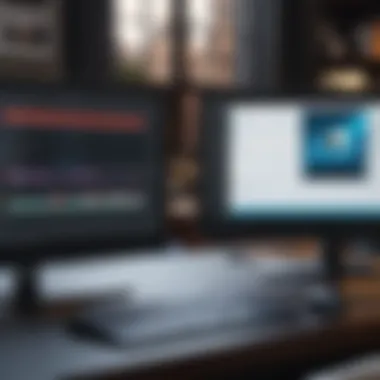
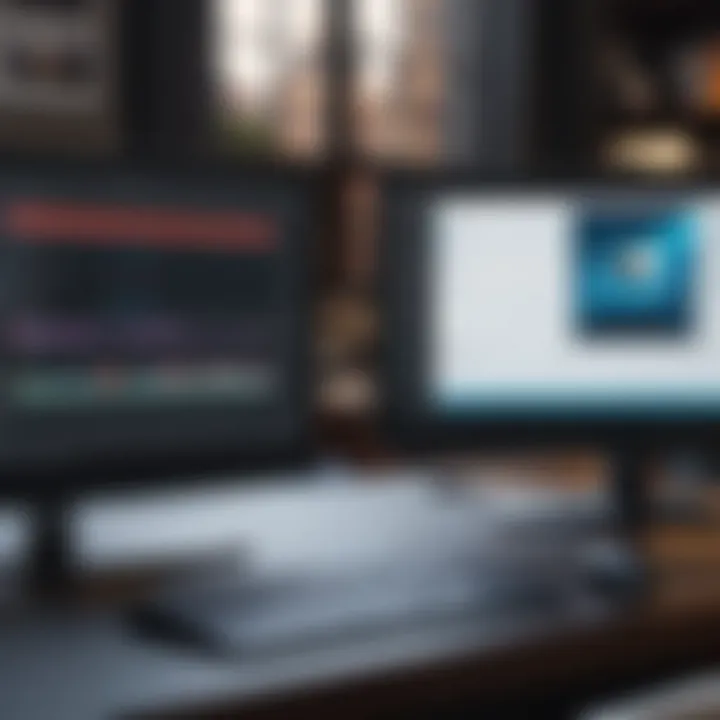
Complexity for Novice Users
Despite its features, Da Vinci Resolve has a steep learning curve, which can be daunting for novice users. The interface is multifaceted, with numerous panels and options that may overwhelm someone new to video editing software. For beginners, basic editing actions might feel complex and unintuitive.
Some challenges include:
- Navigation: Understanding the layout and functionalities of different workspaces can be time-consuming.
- Features: Many advanced features are not adequately covered in beginner tutorials, leaving new users confused.
- Color Grading: The sophisticated color correction tools, while powerful, may be complex to use without prior training in color theory.
This complexity can hinder productivity and deter some users from fully embracing the software. While it provides rich capabilities for professional users, novice users might take longer to gain proficiency. Investing time in learning resources can mitigate some of these complexities.
"The initial barrier of complexity can often lead to frustration, but with time and practice, the software becomes a valuable asset for any creator."
In summary, although Da Vinci Resolve provides an array of compelling features, users must consider the high system demands and the complexities that come with its use. Addressing these limitations can lead to a more productive and efficient editing experience.
Comparison with Other Video Editing Software
When discussing video editing software, it is essential to consider how each solution fits into the broader landscape of available tools. This analysis of Da Vinci Resolve includes comparisons with leading software like Adobe Premiere Pro and Final Cut Pro. Each of these tools has unique strengths, weaknesses, and target audiences. Understanding these differences can guide users in selecting the software that best meets their needs.
Da Vinci Resolve vs. Adobe Premiere Pro
Adobe Premiere Pro is a staple in the video editing industry. It is widely used by professionals due to its robust feature set and flexibility. Premiere Pro integrates seamlessly with other Adobe tools, such as After Effects and Photoshop. This integration allows for a streamlined workflow, particularly for users engaged in various aspects of media production.
In contrast, Da Vinci Resolve emphasizes color grading and correction as its standout feature. While Premiere Pro offers significant editing capabilities, Resolve excels in creating visually stunning edits through its advanced color tools. This specialization makes Da Vinci Resolve a preferred choice for projects where color is a priority.
Here are some key factors to consider when comparing these two:
- Usability: Premiere Pro is often praised for its intuitive interface. Yet, Da Vinci Resolve has made strides in recent updates to simplify user navigation.
- Color Correction: Da Vinci Resolve's color grading features are among the best available, setting it apart from Premiere Pro.
- Pricing: Both tools offer subscription models; however, Resolve provides a free version that includes many professional features, making it more accessible for beginners.
Ultimately, the choice between Da Vinci Resolve and Adobe Premiere Pro will depend on individual needs. If color grading is a priority, Resolve may be the better option.
Da Vinci Resolve vs. Final Cut Pro
Final Cut Pro, exclusive to macOS, is renowned for its performance and user-friendly design. It allows video editors to work efficiently with large files, making it a favorite among filmmakers. The software integrates well with other Apple products and services, including Motion, for enhanced visual effects processes.
In terms of editing features, Final Cut Pro focuses on magnetic timelines and unique organizational tools that may appeal to filmmakers. However, Da Vinci Resolve offers comprehensive features that combine non-linear editing with extensive post-production capabilities. Its robust suite includes advanced audio control and visual effects that are foundational to high-quality production.
When reviewing both:
- Operating System: Final Cut Pro is optimized for macOS, while Da Vinci Resolve is available on both Windows and Mac.
- Performance: Final Cut Pro is often recognized for faster rendering times due to its optimized performance on Mac hardware.
- Learning Curve: Many users find Final Cut Pro to be more approachable, whereas Resolve may present challenges for novices.
Ultimately, the decision rests upon the user's requirements, the operating system in use, and the specific features they prioritize in their video editing workflow.
User Community and Support
The user community and support structure for Da Vinci Resolve play a crucial role in enhancing the overall experience for users, ranging from novices to experts. A thriving user community provides a platform for sharing knowledge, troubleshooting issues, and facilitating the exchange of creative ideas. Support from fellow users and professionals often contributes greatly to an individual's learning curve, making it an indispensable aspect of utilizing this sophisticated software. With a variety of online resources and official support channels available, Da Vinci Resolve users can effectively navigate challenges and maximize the software's extensive features.
Online Forums and Resources
Online forums and resources are the backbone of Da Vinci Resolve's user community. These platforms allow users to connect, ask questions, and share solutions in real-time. Notable forums include DaVinci Resolve subreddits on Reddit, where users can engage in discussions on various topics. Moreover, dedicated forums like the Blackmagic Design user forum present a space for users to post issues, share tips, and collaborate on different projects.
Additional resources such as YouTube video tutorials and blogs are essential for users seeking hands-on demonstrations of specific features. Comprehensive guides help demystify complex tools, while community-driven content offers practical advice based on firsthand experience. Thus, users can access a wide array of information tailored to both their skill level and the particular areas where they need assistance.
Official Support Channels
Official support channels provided by Blackmagic Design, the creators of Da Vinci Resolve, ensure that users receive reliable and professional assistance. The primary support options include a detailed knowledge base and help documents available on the Blackmagic Design website. These resources focus on common problems, installation guides, and troubleshooting advice, which can be invaluable for resolving technical issues.
Additionally, Blackmagic Design offers technical support via email, allowing users to communicate with experts directly. This channel is especially useful for users who encounter unique challenges that are not covered in the existing documentation.
Importantly, staying connected with the latest updates and features through Blackmagic Design’s official social media accounts can enhance user engagement. Followers receive timely information about new releases, updates, and best practices, further supporting their journey with Da Vinci Resolve.
"The strength of a community lies in its shared knowledge and collective experience. Da Vinci Resolve's user community exemplifies this principle perfectly."
Updates and Future Developments
The topic of updates and future developments in Da Vinci Resolve holds significant value in this analysis. Regular updates ensure the software remains relevant in a fast-evolving digital landscape. With the landscape of video editing technology evolving swiftly, staying ahead requires software to continuously integrate new features, improve user experiences, and address existing limitations. Users, both professionals and amateurs, benefit greatly from enhancements that optimize functionality and streamline workflows.
Recent Features and Improvements
Recent updates to Da Vinci Resolve have introduced several key enhancements that improve its usability and expand its capabilities. One notable addition is the enhanced HDR (High Dynamic Range) tools. This allows for more vibrant color grading and accurate reflections of visual intent.
- Improved Collaboration Tools: This feature enables multiple users to work on the same project simultaneously. This is crucial for teams in larger production environments.
- Machine Learning Integration: Features like smart reframing and facial recognition are powered by AI, making editing more efficient.
- Enhanced Fairlight Audio Tools: These audio capabilities have been expanded to offer better mixing and sound design options.
These features demonstrate a committed response to the needs of users who require robust solutions for modern editing challenges.
Expected Features in Future Releases
Looking forward, Da Vinci Resolve is expected to continue its trend of innovation. Anticipations include:
- Expanded AI Features: Further integration of AI could add capabilities such as automated color correction and improved sorting of footage based on context.
- Improved Multicam Editing: Enhancements in this area could allow for smoother interactions and more intuitive workflows.
- Cloud Collaboration Tools: As remote work becomes more common, cloud-based features may be developed to facilitate easy sharing and team collaboration.
As the demand for high-quality video content increases, Da Vinci Resolve’s evolution will play a critical role in meeting user needs while adapting to industry trends. Ultimately, updates keep the software competitive and capable of handling the complexities of modern video editing.
Ending
The relevance of concluding remarks in this article cannot be overstated. The conclusion serves as a synthesis of the comprehensive exploration of Da Vinci Resolve, reiterating its significance as a video editing software. Understanding the essence of this software allows users, whether professionals or enthusiasts, to leverage its strengths and navigate its complexities effectively.
Recap of Da Vinci Resolve
Da Vinci Resolve stands out as a versatile video editing solution, integrating various functionalities that cater to different needs. It excels in editing capabilities, color correction, and audio post-production. This combination aids users in achieving high-quality results across various projects. Whether in film production or content creation, its user-friendly interface supports efficient and creative workflows.
Final Thoughts on Its Value
In a rapidly evolving digital landscape, Da Vinci Resolve is not just a tool but a comprehensive ecosystem for video editing. Its free version provides access to many features, effectively lowering barriers to entry for newcomers. For seasoned professionals, the software’s advanced capabilities make it an invaluable asset in their toolkit. Additionally, staying updated on its enhancements positions users to maximize their projects. Ultimately, Da Vinci Resolve represents a convergence of affordability, functionality, and innovation that meets diverse editing demands.



